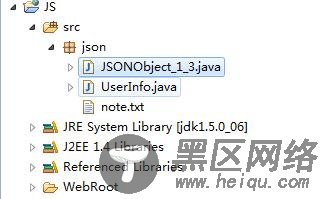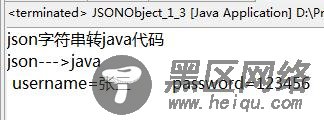JSONObject-lib包是一个beans,collections,maps,java arrays和xml和JSON互相转换的包。
2.下载jar包
提供了除JSONObject的jar之外依赖的其他6个jar包,一共7个jar文件
说明:因为工作中项目用到的版本是1.1的对应jdk1.3的版本,故本篇博客是基于1.1版本介绍的。
3.项目环境:
system:WIN7 myeclipse:6.5 tomcat:5.0 JDK:开发环境和编译用的都是1.5
项目结构如下:

说明:本次用到的的文件只有工程目录json包下的JSONObject_1_3类和note.txt
4.class&method 基于1.1的API
做以下几点约定:
1.介绍基于JSONObject 1.1的API
2.只介绍常用的类和方法
3.不再介绍此版本中已经不再推荐使用
4.介绍的类和方法主要围绕本篇博客中用到的
JSONObject:A JSONObject is an unordered collection of name/value pairs.
是一个final类,继承了Object,实现了JSON接口
构造方法如下:
JSONObject();创建一个空的JSONObject对象
JSONObject(boolean isNull);创建一个是否为空的JSONObject对象
普通方法如下:
fromBean(Object bean);静态方法,通过一个pojo对象创建一个JSONObject对象
fromJSONObject(JSONObject object);静态方法,通过另外一个JSONObject对象构造一个JSONObject对象
fromJSONString(JSONString string);静态方法,通过一个JSONString创建一个JSONObject对象
toString();把JSONObject对象转换为json格式的字符串
iterator();返回一个Iterator对象来遍历元素
接下来就是一些put/get方法,需要普通的get方法和pot方法做一下强调说明,API中是这样描述的:
A get method returns a value if one can be found, and throws an exception if one cannot be found. An opt method returns a default value instead of throwing an exception, and so is useful for obtaining optional values.
JSONArray:A JSONArray is an ordered sequence of values.
是一个final类,继承了Object,实现了JSON接口
构造方法如下:
JSONArray();构造一个空的JSONArray对象
普通方法如下:
fromArray(Object[] array);静态方法,通过一个java数组创建一个JSONArray对象
fromCollection(Collection collection);静态方法,通过collection集合对象创建一个JSONArray对象
fromString(String string);静态方法,通过一个json格式的字符串构造一个JSONArray对象
toString();把JSONArray对象转换为json格式的字符串
iterator();返回一个Iterator对象来遍历元素
接下来同样是put/get方法……
XMLSerializer:Utility class for transforming JSON to XML an back.
一个继承自Object的类
构造方法如下:
XMLSerializer();创建一个XMLSerializer对象
普通方法如下:
setRootName(String rootName);设置转换的xml的根元素名称
setTypeHintsEnabled(boolean typeHintsEnabled);设置每个元素是否显示type属性
write(JSON json);把json对象转换为xml,默认的字符编码是UTF-8,
需要设置编码可以用write(JSON json, String encoding)
5.对XML和JSON字符串各列一个简单的例子
JSON:
{"password":"123456","username":"张三"}
xml
<?xml version="1.0" encoding="UTF-8"?> <user_info> <password>123456</password> <username>张三</username> </user_info>
start
新建web工程,工程名称JS,导入以下7个jar包,文件在前面的准备工作中下载路径。
说明:可以不用新建web工程,普通的java工程也可以完成本篇的的操作。至于为什么要导入处json包以外的其他6个包,我会把note.txt贴在最后,各位一看便知。
question1:后台接受到前台的json格式的字符串怎么处理?
public static void jsonToJAVA() { System.out.println("json字符串转java代码"); String jsonStr = "{\"password\":\"\",\"username\":\"张三\"}"; JSONObject jsonObj = JSONObject.fromString(jsonStr); String username = jsonObj.getString("username"); String password = jsonObj.optString("password"); System.out.println("json--->java\n username=" + username + "\t password=" + password); }

question2:后台是怎么拼装json格式的字符串?
